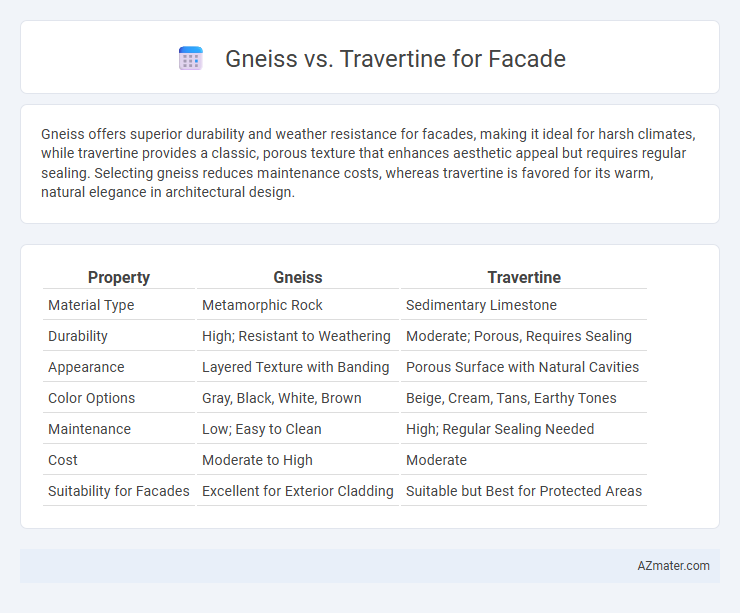Gneiss offers superior durability and weather resistance for facades, making it ideal for harsh climates, while travertine provides a classic, porous texture that enhances aesthetic appeal but requires regular sealing. Selecting gneiss reduces maintenance costs, whereas travertine is favored for its warm, natural elegance in architectural design.
Table of Comparison
| Property | Gneiss | Travertine |
|---|---|---|
| Material Type | Metamorphic Rock | Sedimentary Limestone |
| Durability | High; Resistant to Weathering | Moderate; Porous, Requires Sealing |
| Appearance | Layered Texture with Banding | Porous Surface with Natural Cavities |
| Color Options | Gray, Black, White, Brown | Beige, Cream, Tans, Earthy Tones |
| Maintenance | Low; Easy to Clean | High; Regular Sealing Needed |
| Cost | Moderate to High | Moderate |
| Suitability for Facades | Excellent for Exterior Cladding | Suitable but Best for Protected Areas |
Introduction to Gneiss and Travertine
Gneiss is a durable, metamorphic rock characterized by its banded texture and high resistance to weathering, making it an excellent choice for building facades requiring strength and longevity. Travertine, a sedimentary limestone formed by mineral deposits from hot springs, offers a distinct porous texture and warm, natural hues ideal for elegant and classic architectural designs. Both materials provide unique aesthetic and structural properties, with gneiss favored for robustness and travertine prized for its timeless beauty and versatility in facade applications.
Geological Formation and Composition
Gneiss forms through high-grade regional metamorphism of pre-existing rocks, characterized by its banded texture with alternating light and dark mineral layers primarily composed of quartz, feldspar, and mica. Travertine is a sedimentary rock created by the rapid precipitation of calcium carbonate from mineral-rich waters, often exhibiting porous and fibrous textures with calcite or aragonite as its main components. The durability and appearance of gneiss make it suitable for facades requiring strength, while travertine offers a distinctive, natural aesthetic due to its porous, earthy composition.
Aesthetic Appeal: Color and Texture Comparison
Gneiss offers a striking aesthetic for facades with its banded, foliated texture and natural range of earthy tones including gray, pink, and brown, providing a rugged yet elegant appearance. Travertine presents a softer, more uniform texture characterized by its porous, pitted surface and warm color palette consisting of creamy beige, ivory, and light tan hues, lending a timeless Mediterranean charm. The choice between gneiss and travertine hinges on the desired visual impact, with gneiss emphasizing bold, dynamic patterns and travertine delivering subtle warmth and classic sophistication.
Durability and Weather Resistance
Gneiss offers superior durability and excellent weather resistance due to its high-density mineral composition and foliated structure, making it highly resistant to abrasion and environmental wear for facade applications. Travertine, while aesthetically appealing with its porous texture, is more susceptible to weathering and erosion, requiring regular sealing to maintain its integrity against moisture and freeze-thaw cycles. Choosing gneiss ensures long-lasting facade performance in harsh climates, whereas travertine is better suited for mild conditions with protective maintenance.
Maintenance Requirements
Gneiss requires minimal maintenance for facades, with its dense, durable structure resisting weathering and staining effectively. Travertine demands more frequent cleaning and sealing to prevent porosity-related issues such as water absorption and surface erosion. Choosing gneiss reduces long-term upkeep costs, while travertine offers a distinctive aesthetic that needs regular care to preserve its appearance.
Cost Analysis: Gneiss vs Travertine
Gneiss offers a cost-effective option for facades due to its abundant availability and durability, typically priced lower than travertine, which is a premium natural stone known for its elegant appearance and higher extraction and processing expenses. Travertine's installation costs are generally higher, driven by its porous nature requiring sealing and more intricate handling to prevent damage, whereas gneiss demands less maintenance and simpler installation processes. Choosing between gneiss and travertine for facade applications involves balancing initial material costs with long-term maintenance expenses, where gneiss provides economic efficiency and travertine offers superior aesthetic value.
Environmental Impact and Sustainability
Gneiss, a naturally occurring metamorphic rock, offers superior durability and minimal environmental impact due to its low processing energy and longevity in facade applications. Travertine, a sedimentary limestone, requires intensive quarrying and chemical treatments which increase its carbon footprint and reduce overall sustainability. Choosing gneiss enhances facade longevity and reduces resource depletion, making it a more eco-friendly option compared to travertine.
Installation Process and Challenges
The installation process for gneiss involves precise cutting and anchoring due to its dense, hard texture, requiring heavy-duty tools and experienced stone masons to ensure durability and proper alignment. Travertine, being softer and more porous, demands careful sealing and stabilization during installation to prevent moisture absorption and cracking, posing challenges in maintaining structural integrity over time. Both materials require specialized techniques tailored to their physical properties to achieve a secure and visually appealing facade.
Performance in Different Climates
Gneiss offers exceptional durability and resistance to weathering, making it ideal for facades in harsh, cold, and coastal climates due to its low porosity and high mineral density. Travertine, with its porous structure, performs well in temperate and dry climates but requires sealing to protect against moisture infiltration and freeze-thaw damage in colder regions. Both stones provide aesthetic versatility, but gneiss ensures longer lifespan and lower maintenance in extreme environmental conditions.
Best Applications for Façade Design
Gneiss offers exceptional durability and natural resistance to weathering, making it ideal for facades exposed to harsh climates and urban pollution. Travertine's unique porous texture and warm, earthy tones provide aesthetic appeal suited for luxury residential and commercial facades emphasizing elegance and historical character. Choosing between Gneiss and Travertine for facade design depends on balancing durability requirements with desired visual impact and maintenance considerations.

Infographic: Gneiss vs Travertine for Facade
 azmater.com
azmater.com